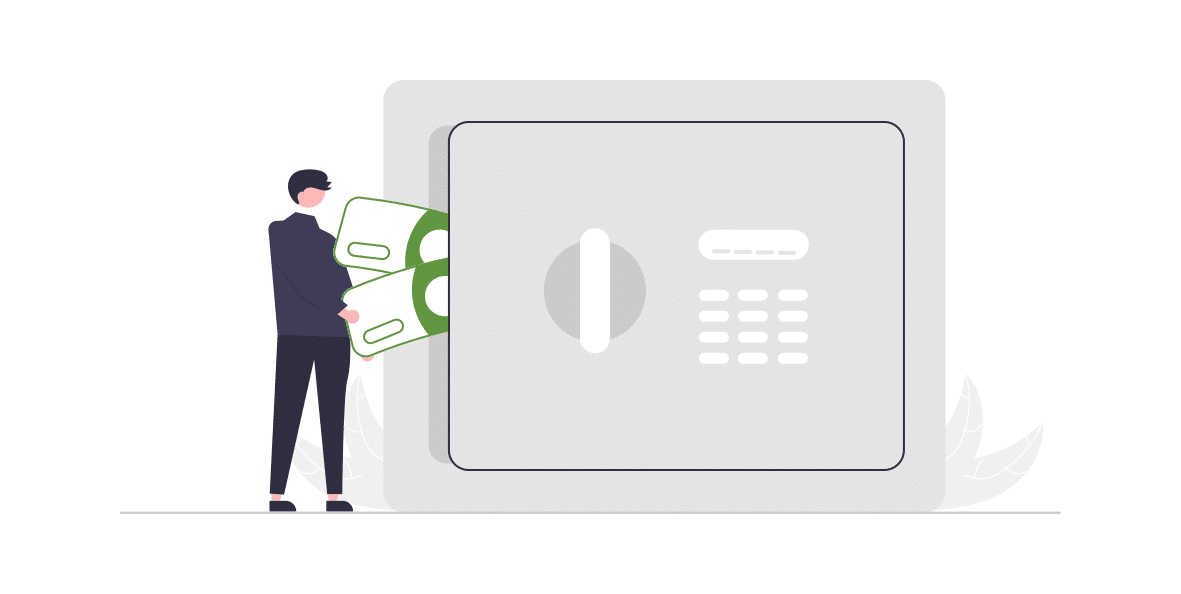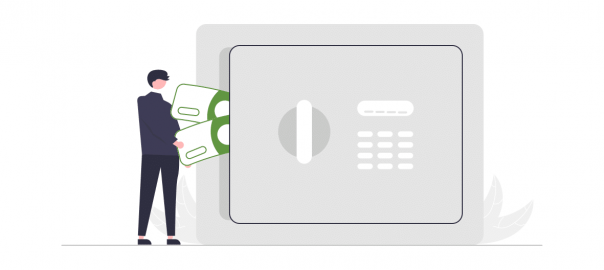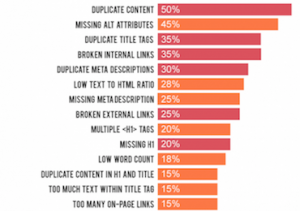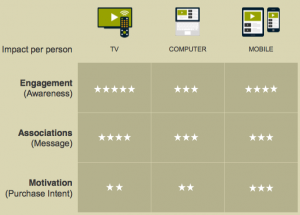
When your finances are in order, you just feel better. You also have a better sense of how to save and plan for your financial future. Plus, you have less to worry about at night, and you know the complete picture of your wealth.
Sound good? Unfortunately, a vast majority of Americans suffer from a lack of personal financial planning. How bad is this problem? CNBC reporting suggests that around three-quarters of all adults are just “winging it” when it comes to money matters. Just as troubling, Bankrate has determined that 28% of people age 18 and older have no cash reserves.
These are problematic findings, especially with the specter of inflation on the horizon. True, you can’t stop inflation from happening. However, you can protect yourself when it comes to stashing away funds for those “down the road” times. (Note: They’ll come sooner than you expect.)
You don’t have to be a “masterful money mogul” to create a personal financial playbook, either. Anyone can start small and become more cash savvy. That’s the beauty of wealth: It’s never too late to put smarter measures into place.
Below are several ways to avoid foreseeable money-related hardships in the years ahead. You don’t have to implement all of them to enjoy peace of mind and more coins in your coffers. Nevertheless, the more you try, the faster you’ll enjoy additional freedom from financial worries.
Here are 5 ways to plan for your financial future:
1. Create a household budget.
Money management begins and ends with knowing how much cash is coming into and flowing out of your wallet. Set up a digital or old-fashioned paper spreadsheet documenting all the money you make each month. could be from paychecks, a side gig, irregular income streams, gifts, child support, alimony, or other revenue sources. Keep careful track, right down to the quarters and dimes you find while walking from the parking lot to your office building.
After documenting all your incoming dollars, start tracking what you spend. To make this process easier and ensure you don’t forget anything, update your spreadsheet for the next month. Include every purchase, right down to your favorite morning latte or street vendor vegetarian pita.
You know what comes next: Add up all your revenue and your expenses. Ideally, the money you bring in should be higher than the money you spend. If it’s not, go back to your expenses. What could you cut? People who engage in this exercise are often shocked to realize how many unnecessary purchases they make. Just spending $ 10 daily adds up to $ 300 in the average month.
With a budget in hand, you can start to answer all those nagging questions: Why can’t I save more? Why does it seem like I’m living paycheck to paycheck? Seeing everything in black and white gives you the opportunity to start making informed money changes.
2. Shop around before buying.
It doesn’t matter what you’re buying: You owe it to yourself to make sure you’re getting the best deal. This is true whether you’re seeking out the best home warranty or safest family vehicle. Why? To be honest, when you make any purchase suddenly, you lose your money perspective.
Consider all the impulse buys you’ve made in your life. Maybe you splurged on an outfit that you didn’t need. Or you saw a piece of technology that you “couldn’t resist” despite its outrageous price tag. Businesses count on impulsive purchases to help them stay afloat. However, spending money without objectivity and pragmatism can lead to financial disaster.
At first, shopping around may be difficult for you. After all, you won’t get the instant gratification that comes with buying something right away. In time, you’ll realize that weighing all your options improves your confidence. It also allows you to understand whether a purchase is adding value or not.
This doesn’t mean you have to resist picking up a pack of gum or a farmer’s market floral bouquet occasionally. Small treats can be important to keep you from feeling like you’re being too constricted. Nevertheless, aim to evaluate any purchases over a specific dollar amount. This could be $ 5 or $ 100. You get to choose. Just make sure you stick with the process.
3. Set short-term and long-term financial goals.
A plan for your financial future wouldn’t be complete if it didn’t have a purpose. Consequently, you’ll want to set aside some objectives. These should include money-related goals for both the near and far terms.
Common financial goals can include buying a new house within two years, paying off your student loans or other debts faster, or being able to donate more to charities. Set goals that are meaningful to you and make sense based on your current status. You may want to tweak them later, but they’re important to put into place right away.
As you create your objectives, be as specific as you can. It’s not enough to say you want to save up for retirement. While that’s a good start, it doesn’t really tell you anything. Instead, you might want to say that you want to have one million dollars in savings by the time you’re 60. If you’re 30 now, you know that you have 30 more years to make your dream happen.
One caveat: Plenty of people try to set financial goals that aren’t realistic in the allotted time frame. Therefore, be certain to vet all your goals to ensure they’re not going to become de-motivators. Your goals need to be achievable so you can hit money management milestones.
4. Weigh good versus bad debt.
The word “debt” often carries a negative stigma. Yet all debt isn’t bad. Some debt can be good, especially if it allows you to get closer to what you want. A good example of this might be if you’re starting your own business. Taking out a commercial or personal loan could help you set up shop and wow your first customers. Without upfront capital (aka, debt,) you might never get the chance to launch your startup.
On the other hand, maxing out your high-interest rate credit cards with no real way to pay off the money isn’t good debt. It’s a bad idea that will make it harder for you to reach your financial planning objectives. Regrettably, the average Millennial owes $ 4,000 to credit card issuers. That’s a stumbling block, although it’s not insurmountable.
Just as you mapped out your budgeting spreadsheet, map out your current debt. Remember that debt should include any money you owe. This means mortgages are debt. So are any high medical bills that you’re paying down through monthly installments. Once you have all your debts front and center, you can gauge if they are good or bad.
At that point, start setting aside money to make the bad debt go away quickly. A good example could be to pay double or triple the minimum monthly charge on your credit card. Not only will you save in fees, but you’ll reduce your bad debt.
5. Get a handle on your credit score.
Did you know that the average credit score for Americans is just under 700? With subprime credit at just under 620, a score of 700 isn’t too shabby. Nonetheless, you shouldn’t just accept your credit score as-is. The higher your score, the more choices you have when it comes to spending money well.
You can find out your credit score online soon. The three major credit bureaus—Equifax, Experian, and TransUnion—will all give you a free credit report annually. All you have to do is sign up on their websites. Your credit report will show you an estimate of your score, as well as a complete lineup of all your outstanding debts.
Don’t like the credit score that you see? Not a problem, because credit scores can bounce back rapidly. Some methods of improving your score include paying bills on time, keeping your debt-to-income load low, having the right mix of debt, and reporting any errors to the credit unions promptly. In addition, Experian offers Experian Boost to bump up your Experian-based credit score by leveraging paid utility bills.
Ultimately, having an outstanding credit score will help you attain your money goals. People with good to excellent credit are typically offered lower interest rates. Plus, they have more options when they need to go into debt to purchase a car or other investment. Some landlords and employers check credit scores to determine whether or not to work with people, too. As a result, your credit score could enable you to live in a better neighborhood or get accepted at your (hopefully higher-paying) dream job. And, when planning for your financial future, having these things in your corner is a huge advantage.
6. Take advantage of employer benefits.
Unless you work for yourself, you may have multiple benefits available through your employer. But if you’re like half the working population, you might not understand all the benefits and perks at your disposal.
Take time to go through your employer benefits package offerings again. If you can’t find the paperwork, contact your human resources representative to get duplicate copies or online access. Then, scour over the documents. Are there any opportunities you’ve missed? These might include setting up a health savings account (HSA) or contributing to a retirement vehicle like a 401k program.
How will employer-based benefits make the road to money management less stressful and more successful? Consider a 401k with matching contributions. Employers may offer a match up to a certain percentage of your income, such as 5% of your income. That means if you put 5% of each paycheck into your 401k, your employer will add just as much. You’d be getting 10% of your salary while only paying 50%, which is like “found money” for the future.
Not all employer benefits will directly put dollars into today’s or tomorrow’s pocket. Still, they can be just as financially attractive. Let’s say you make better use of all the healthcare insurance available through your work, including preventive screenings. If a provider finds an issue early, you could avoid spending money on medical problems related to unaddressed concerns.
Like it or not, the years will pass and you’ll end up older than you are at this moment. Be certain that you have the money you need then by taking assertive steps to plan for your financial future now.
Business & Finance Articles on Business 2 Community
(64)









